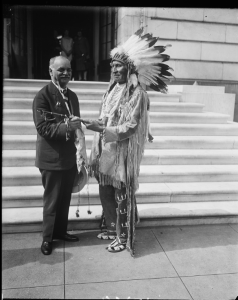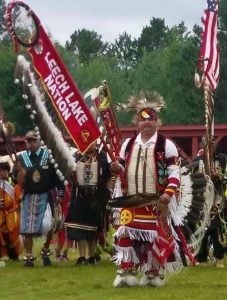WASHINGTON – June 2 marked one century since then-President Calvin Coolidge signed a law granting American citizenship to Native Americans.
Women had secured the right to vote four years earlier under the 19th Amendment. For the nation’s 250,000 or so Native Americans, the Indian Citizenship Law promised acceptance, economic opportunity and legal protections.
But it was not intended to ensure voting rights.
That remained the purview of states, and many threw up obstacles for decades. Arizona, in particular, used literacy tests and other tools to quash voting rights of Americans who also happened to be Native American.
Four years after Congress adopted the new law, two members of the Gila River Indian Community tried to register to vote in Pinal county. The county recorder turned them away.
Under the state’s logic, Peter Porter and Rudolf Johnson weren’t eligible to vote because they lived on the reservation, did not pay taxes and had the legal status of wards of the state.
The Arizona Supreme Court upheld the ban, finding that being “under guardianship” of the federal government made Native Americans ineligible to vote in the state.
The ban lasted until 1948.
“My grandmother was born here in Arizona in 1912,” recounted Gabriella Cázares-Kelly, who is Tohono O’odham, “but she was not able to speak English. She didn’t read or write in English. She was a brilliant woman, so smart, and a community leader.”
None of that mattered when it came to voting.
In 2020, Cázares-Kelly won the job of recorder in Pima county, which includes Tucson – the first Indigenous countywide elected official in Pima county.
“Being the granddaughter of somebody who couldn’t vote until they were 30 years old, and really not until their 50s … and now being an elections officer of the second-largest county in Arizona and having this position of influence and power, it is really humbling,” she said.
Before Congress sent the Indian Citizenship Act to Coolidge’s desk in 1924, Native Americans were not considered citizens of the United States.
“They did not have a lot of rights when it came to leaving the reservations, finding jobs and homes, going to schools and so forth,” said David Martínez, a professor of American Indian Studies at Arizona State University who is Akimel O’odham and Hia-Ced O’odham. “It was a segregation system.”
Some Native Americans did manage to obtain U.S. citizenship before 1924. But that often came at a high price.
The 1830 Treaty of Dancing Rabbit Creek offered citizenship to Choctaw who chose to stay in Mississippi after their lands were seized under the Indian Removal Act. Over the next two decades, an estimated 100,000 people were forcibly removed from their lands east of the Mississippi, ending up in what is now Oklahoma after a dangerous trek on the infamous Trail of Tears.
The Dawes Act of 1887 promised citizenship to those who gave up their tribal citizenship, paid taxes, moved to assigned plots of land and adopted “white” clothing and ways.
Many would-be citizens weren’t told about the option. Many who met those requirements still never received citizenship, on grounds they hadn’t assimilated sufficiently.
Some states conferred citizenship, albeit sparingly, to Native Americans who left their reservations and assimilated completely. Native American women who married white men were eligible, as were their offspring.
Charles Curtis, a Kansas Republican with three-eighths Native American ancestry – Kaw, Osage and Potawatomi – became the first Native American elected to the U.S. House in 1893, and the first elected to the U.S. Senate in 1907.
By the time he was elected vice president in 1928 as Herbert Hoover’s running mate, he’d risen to Senate majority leader.

Vice President Charles Curtis receives a peace pipe from Chief Red Tomahawk on June 21, 1929, in Washington, D.C. (Photo courtesy of Library of Congress)
But Curtis’ rise to power said less about expansion of rights and acceptance into the American mainstream than about the power of assimilation, of which Curtis himself was a strong advocate.
The infamous Curtis Act of 1898 abolished tribal governments and communal land holdings – a direct assault on tribal sovereignty that had a devastating effect on the Cherokee, Choctaw, Chickasaw, Creek and Seminole.
Curtis also supported the Indian Citizenship Act in 1924, which some tribal groups opposed out of concern it would undermine tribal identity.
The Onondaga Nation accused Congress of attempting forced assimilation by conferring U.S. citizenship on Native Americans without their consent. As recently as 2018, the tribe reaffirmed its position that the U.S. government had no authority to declare its members U.S. citizens.
Rep. Homer P. Snyder, a New York Republican who chaired the House Committee on Indian Affairs in the early 1920s, introduced the historic measure. One objection raised – by Rep. Finis J. Garrett, a Tennessee Democrat – had to do with whether the legislation would override state law on voter eligibility.
Snyder assured him it would not.
There were other objections. As the New Mexico Historical Review recounted, Herbert J. Spinden of the Peabody Museum at Harvard University, a member of the American Indian Defense Association – founded to protect tribal rights – vehemently opposed the act.
Spinden argued that Native Americans had “not developed politically or sufficiently” to justify citizenship and that “the bulk of Indians … would form a dangerous mass of alien stock in our political system if they were given the privilege of citizenship.”
Such arguments did not deter Congress.
Coolidge signed the measure into law on June 2, 1924.
“All noncitizen Indians born within the territorial limits of the United States be, and they are hereby, declared to be citizens of the United States,” the law said.
The Fourteenth Amendment, adopted after the Civil War, granted citizenship to all people born or naturalized in the nation, excluding “Indians not taxed.”
The 1924 law gave citizenship to all Native Americans regardless of whether they lived on or off a reservation, or had married a white person.
“The way that the 1920s generation of Indian rights advocates spoke about Indian human rights was in terms of U.S. citizenship rights. If Indian people can be accorded citizenship rights, then under American law, maybe they’ll be treated more like fellow human beings,” said Martínez, the ASU professor.
Arizona was the last state with an outright ban on voting for Native Americans. World War II was a catalyst as soldiers returned from fighting and pressure grew for civil equality.
Approximately 44,000 Native Americans saw active duty. Of the predominantly Pima and Navajo soldiers of the famous 158th Infantry Regiment General Douglas MacArthur remarked, “No greater fighting combat team has ever deployed for battle.”

General Douglas MacArthur, who commanded the Allied forces in the Southwest Pacific Area, with representatives from five Native American tribes in 1943. (Photo courtesy of U.S Signal Corps)
The Navajo Code Talkers, 29 men picked by the Marine Corps to create an unbreakable code, were instrumental to the Allies’ victory in the Pacific theater.
But coming home when the war ended in 1945, many could still not vote.
Maricopa County denied attempts by two Army veterans – Yavapai from Fort McDowell, Frank Harrison and Harry Austin – to register in 1947.
This time, the Arizona Supreme Court was more sympathetic.
“In a democracy suffrage is the most basic civil right, since its exercise is the chief means whereby other rights may be safeguarded,” Justice Levi Udall wrote as the court reversed its own 1928 ruling.
But the victory in court still didn’t guarantee access to the polls.
“Just like other people of color, like Black communities, we were not able to participate due to discrimination, due to writing tests, poll taxes. The KKK would literally be standing outside of polling locations,” said Cázares-Kelly, the Pima County recorder.
The Voting Rights Act of 1965 cemented protections for Native Americans, as for other groups that had historically faced discrimination.
Obstacles Remain
Turnout remains relatively low, though, and many Native Americans still face obstacles.
“We’re asking people who were once targeted by the United States government to now participate. And that’s very difficult,” said Cázares-Kelly, the Pima County recorder. “It’s a difficult thing for people to have to shift their mindset and recognize that their vote counts.”
Poll workers often don’t realize that tribal enrollment cards are a valid form of voter ID under state law, according to Martínez, despite clear guidance from the Secretary of State and the Arizona Clean Elections Commission.
Another ongoing problem is that many people who live on reservations have no street address.
In 2012, Apache County purged 500 Navajo voters because the county recorder didn’t accept certain P.O. boxes.
Some applicants drew maps on registration forms to show where they resided. Those, too, were rejected.
Apache, Navajo and Coconino counties had especially high rates of ballots being rejected in 2012 because of confusion over residency. Such problems persisted into the 2020 election, when over 2,000 Apache County voters had their registration suspended due to questions over their addresses, according to the Native American Rights Fund.
Last September, a federal judge ruled in favor of the Tohono O’odham and Gila River tribes in a challenge to Arizona law requiring proof of a physical address. Critics called the law an attempt at voter suppression, given that at least 40,000 homes on reservations in Arizona have no standard street address.
Other outcomes of the ICA

Charles Michaud, wearing handmade regalia, at a powwow at Red Lake Reservation in Minnesota in 2015. (Photo courtesy of Charles Michaud)
By excluding the right to vote, the law Congress adopted a century ago left much to be desired for Native Americans.
Yet it’s still viewed as an important milestone, affirming their status in two cultures.
Charles Michaud, 50, an Ojibwe-Anishinaabe Native American born and raised on Leech Lake Reservation in Minnesota, joined the Marines when he was 18.
His grandmother was among the Native Americans forced to attend one of the many boarding schools where children faced corporal punishment for speaking in their Native language, he said.
About 20 years ago he started attending and dancing at powwows but “when I was younger, I almost hid that I was (Native American),” he said.
Michaud, a shift manager at a steel company in Keewatin, Minn., no longer lives on the reservation.
But he’s more comfortable about publicly celebrating his heritage and hopes his children will, too – in part by exercising their right to vote and making their voices heard.
“My grandfather thought politics was very important. So we’d always watch elections when we were young,” Michaud said. “He said it was very important because his father didn’t get to have the chance.”

